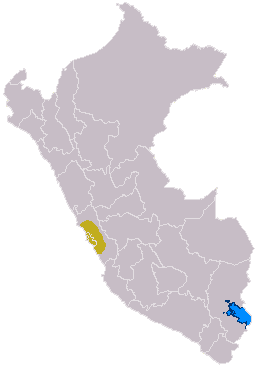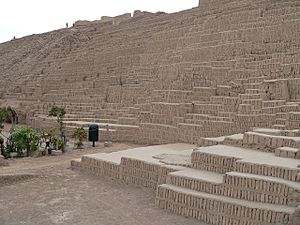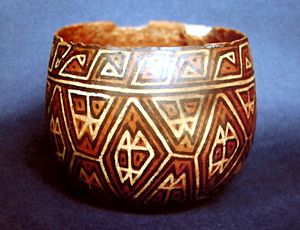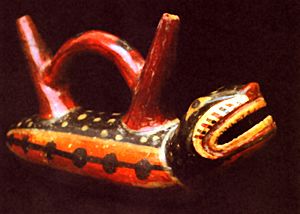Lima culture facts for kids
Quick facts for kids
Lima
|
|||||||||
|---|---|---|---|---|---|---|---|---|---|
| c. 100–c. 650 | |||||||||

The area where the Lima culture lived
|
|||||||||
| Capital | Lima | ||||||||
| Historical era | Early Intermediate | ||||||||
|
• Established
|
c. 100 | ||||||||
|
• Disestablished
|
c. 650 | ||||||||
|
|||||||||
| Today part of | Peru | ||||||||
The Lima culture was an ancient civilization that lived in what is now Lima, Peru. They existed during a time called the Early Intermediate Period, from about 100 AD to 650 AD. This culture lived before the famous Incas. They were located in the desert coastal area of Peru, near the Chillon, Rimac, and Lurin River valleys.
It can be tricky to tell the Lima culture apart from other ancient groups like the Paracas, Moche, and Nasca. This is because they lived in similar areas and at similar times. Because of this, we are still learning a lot about the Lima culture.
The Lima civilization was known for its beautiful pottery. Their pottery styles, like Maranga and Interlocking patterns, show ideas from the nearby Moche culture. Later, their pottery also showed influences from the Wari Empire. Since they lived in a desert, the Lima people needed water for farming. They built amazing irrigation systems, including canals and terraces, to bring water from rivers to their crops.
The Lima civilization also built many temples called wak'as. Many of these ancient sites are still found in modern-day Lima. It's hard for archaeologists to study them without disturbing the busy city. Important centers of the ancient Lima culture included Pukllana, Wallamarka, Cajamarquilla, and Pacha Kamaq.
Contents
Early History and Growth
The story of early Andean cultures is about people learning to live in and change nature. They turned dry deserts into green places where they could grow food. In the Central Coast area, there is strong evidence of organized community life even before the Lima culture. This helped set the stage for the Lima culture to grow.
Even though the coast was a desert, two things helped early people survive. First, they lived near the sea, which gave them plenty of fish and shellfish to eat. Second, the climate varied. From May to October, moisture from the hills helped plants grow on the slopes. Early people could use these plants to add to their seafood diet.
Later, people learned to farm in low areas, using water from rivers and springs. During an earlier time called the Early Horizon Period, groups had regular rainfall. They learned how to grow plants and raise animals. As more people lived there, they started moving towards the coast.
This led to the Early Intermediate Period, when the Lima culture began to thrive. These cultures learned to control nature. They created large irrigation systems and artificial canals. These systems show how well organized the Lima society was. It took a lot of planning to build and keep these systems working.
In Coastal Peru, the Rimac, Chillon, and Lurin rivers flow through what is now Lima. These rivers were important for the Lima culture. At first, there were small pyramid-like buildings in villages. These slowly grew into the large, well-organized centers of the Lima culture. Archaeologists can track the culture's growth by finding Lima pottery and textiles in nearby valleys.
At the start of this period, most people lived in the upper Lurin valley. They had separate houses and short irrigation canals. Slowly, the population grew and moved down the valley. They built longer canals to connect their homes and eventually formed major cities. Important buildings for leaders also started appearing on hilltops. These would become the important wak'as of the Lima culture.
Near the end of the Early Intermediate Period, the Lima culture became very powerful. Perhaps the most important center was the wak'a of Pacha Kamaq. This site remained important to many cultures for over 1,000 years.
Main Centers
Pucllana
Wak'a Pukllana was a very important ancient site for the Lima culture. It was also known as Wak'a Juliana. This major center for administration and ceremonies was built around 500 AD.
Wak'a Pukllana was divided into two main parts by a large wall. To the east of the wall was the administrative and urban area. This part likely had places for public meetings to discuss farming and production. It also had smaller buildings, squares, ramps, and storage rooms.
To the west of the wall was the ceremonial area. This section included a large pyramid made of adobe bricks. It was 500 meters long, over 100 meters wide, and 22 meters high. In this area, priests held religious ceremonies to honor gods and ancestors. The way this wak'a was built shows how the Lima culture was organized. It clearly separated the common people from the leaders and religious figures.
Wak'a Wallamarka
The ancient site of Wak'a Wallamarka is a bit smaller than Wak'a Pukllana. It is also a pyramid made of adobe bricks. But this wak'a has a special, impressive access ramp. Experts believe this site was a ceremonial center. Only religious leaders might have been allowed to enter. This is because the floors show very little wear from use.
Wak'a Wallamarka was used for a very long time, from the 3rd century until the Inca arrived in the 15th century. Studying how it was used and then left helps us understand how burial practices changed over time. This site is still a key source of information about ancient burial customs of the Lima and nearby cultures. Today, the museum at the site shows examples of burial bundles and the mummy of a local princess.
Cajamarquilla
The wak'a Cajamarquilla is in the Rimac valley. It was built around 400-600 AD. It was not a major trading, administrative, or military site during the Early Intermediate Period. People sometimes call Cajamarquilla "the dead city." It is built entirely of adobe bricks. It is special because it has many walled palaces.
Cajamarquilla is the second largest ancient city built with mud in Peru. It covers 167 hectares, only smaller than the city of Chan Chan to the north. Some believe the Huari civilization founded this site. However, it grew while the Lima culture was powerful in the valley. This important regional center had pyramids, squares, streets, rooms, and mazes. These are still clear to see in the dry landscape.
Even though floods from El Niño events often hit this area, it supported a busy civilization. This is shown by many human burials found there. Different decorations on objects also tell us about the people. Some designs were local, others from different parts of the coast or mountains. Many underground cellars stored food. There were also patios for making chicha, an alcoholic drink from corn, for celebrations.
Pachacamac
Pacha Kamaq is famous for its large pyramid temples and colorful adobe walls. It is one of the most important sites built during the Early Intermediate Period. This sacred place was dedicated to the god pacha Kamaq, who was believed to be the "architect of the world."
Wak'a Pacha Kamaq was the most important place for pilgrimages along the coast. People from all over Peru traveled there to give offerings and ask the oracle for advice. The temple was made entirely of raw mudbricks. It had a raised rectangular area in front where pilgrims could leave their gifts.
The Lima culture built and first used this huge religious complex between 200 BC and 600 AD. Pacha Kamaq continued to be used for over a thousand years. The Wari culture arrived around 650 AD. They used the city as a center for their rule in the coastal Andes. Wari influences can be seen in the buildings, pottery, and textiles from this time.
Pacha Kamaq was so important that even after the Inca conquered the area, they left it untouched. The Inca civilization allowed it to exist alongside their own practices. They even added their own style to the site. In fact, the Inca section, built between 1440 and 1533, is the best-preserved part today.
Material Culture
Textiles
Textiles, or woven fabrics, were a sign of importance and wealth. Many mummies have been found wrapped in many layers of finely embroidered tapestries. This showed that the person was powerful in society. These textiles were made from plant fibers, usually cotton, and animal furs like alpaca or llama.
The styles of Lima culture textiles changed over time. This created many different patterns throughout their history. Some parts of the Lima culture wove beautiful, colorful tapestries and blankets. They dyed their creations with natural dyes, making over 190 different shades. At certain times, the textiles used geometric shapes, human-like figures, and animal designs like birds and felines.
Showing objects as animals was common in Andean art. This connected the object to the qualities of that animal. Textiles were used for everything. This included everyday clothes, special robes for religious and political leaders, burial cloths, and wall-hangings for temples and palaces.
It is clear that the ancient Lima culture loved patterns and designs. This is seen in their wide use of the interlocking pattern. In this design, animal or human figures fit together so cleverly. The same pattern appears even when the fabric is turned upside down. Sometimes it is hard to tell where one image ends and another begins.
Communication Through Art
The ancient Peruvians never developed a system of writing with letters. Instead, they used images and signs woven into cloths or painted on fabrics. These images acted like a picture language. They helped communicate their beliefs about the world. This language was based on nature but used a special style. It simplified natural forms to their main features. This way, the images showed a general idea or type, not just one specific thing.
Pottery
The pottery of the Lima culture grew from local red and white pottery. It often had black, strong colors and random negative designs. Common patterns included geometric shapes and snakes with triangle-shaped heads.
Pottery was made in different ways. They clearly used molds, which allowed them to make many copies of certain shapes. Lima culture pottery varied a lot in shape and what it showed. Important social activities were often shown on pottery. These included war, metalworking, and weaving.
Beliefs About the World
For cultures in the central Andes, the world was full of magic and religion. They believed that spirits animated everything. The health of the land and people depended on these spirits being happy. This explains why human sacrifices were sometimes made during droughts or floods. Sacrifices were done to please the gods and show respect.
This is also supported by images on pottery and textiles. These images show sacrifices for a god or deity. They also show offerings presented at temples, like Pachacamac.
Art and Symbols
In Lima culture art, you often see male and female figures. You also see images of the environment, plants, animals, buildings, and daily activities. One scene that appears often is the sacrifice scene. It shows collecting a victim's blood and offering it to a god-like figure.
By studying these images, we can tell male and female figures apart by their body shapes. We can then see their clothes, hairstyles, and connect these to their activities and roles. Goldwork from Colombia often shows animals like birds, jaguars, and sharks. These might be linked to shamanism, a spiritual practice. Birds and images of flying are often connected to the supernatural and visions.
A common image is a figure holding a staff, facing forward. This represents human or supernatural power. Trophy heads of defeated enemies are also common. These show the belief that "blood fertilized the earth." They believed human sacrifice was needed to please the gods. A two-headed snake symbolizes a "supernatural force that keeps the cosmos in harmony." It does this by uniting opposite but complementary parts. Fish and seabirds were also very important. They were a source of food and fertilizer for fields. So, they were the basis of life in the coastal region.
Sacrifice
Sacrifice was very common in early Andean cultures, and the Lima culture was no different. Sacrifices were made to calm gods or as part of religious ceremonies. Human burials, especially of children, found under buildings, were linked to the belief that these offerings would help the building last a long time. This custom is still part of Andean traditions today. However, animals or special objects have replaced human beings.
Leaders and Power
During the Early Intermediate Period, Lima society began to change. Cultures that were once thought to be more group-focused started to develop social, political, and religious leaders. Differences in wealth and power became very clear. You can see this in the buildings and layouts of sites like Pukllana, Cajamarquilla, Wallamarka, and Pacha Kamaq. You can also see it in how much wealth different families had.
Once in power, these leaders likely supported and directed the creation of art and buildings. This helped them keep control over the rest of the people. It firmly established a powerful group of leaders.
Evidence from ceremonial burials strongly supports the idea of an elite class. Archaeologists have found clear differences in burials among the Lima people. Some sites, like the Burial at Sipán, show that a very important person was buried there. The large amount and richness of objects in some burials, compared to the simple ones, clearly show there was a privileged ruling class.
It also seems there was a religious ruling class. This is shown by how religious spaces and temples at important wak'as were built. They were designed to limit access to only the religious and political leaders. This further strengthened the leaders' power and made the rest of the population more dependent on their guidance.
Decline
Around 600 AD, the Andean region started to experience changes in climate and environment. There were cycles of droughts and the El Niño phenomenon. The Lima culture and nearby groups had to make big changes. They moved populations to deal with less rainfall and water. This negatively affected their crops and damaged their wak'as and homes.
This marked the beginning of the Lima culture's decline. As its people slowly spread across Peru looking for better places to live, the Lima culture gradually broke apart. New cultural groups then developed and became powerful in Coastal Peru.
See also
 In Spanish: Cultura lima para niños
In Spanish: Cultura lima para niños




